Like the ketogenic diet, the slow carb diet is based on simple rules and low-carb whole foods that can help promote fat loss and health improvement. Both diets have led to incredible weight loss results of 100 pounds or more.
That being said, the slow carb diet sets itself apart from other low-carb diet plans in many ways, including the incorporation of some carb-rich foods and a cheat day once a week.
This approach may sound refreshingly easy, and it can be highly effective, but there are several nuances to unpack before adding the “s” to low carb. To help you develop a better understanding of this diet and how it may work for you, let’s take a look at the slow carb diet from the following perspectives:
- What is slow carb exactly?
- Slow carb diet rules list
- Other success tips and recommendations
- How does it work? Before and after results of slow-carb
- Criticisms, concerns, and downsides
- How to know if it is right for you
- Slow carb food list
- Slow carb recipes (that are also keto-friendly)
- 7-day meal plan
- Key takeaways
What is the Slow Carb Diet?
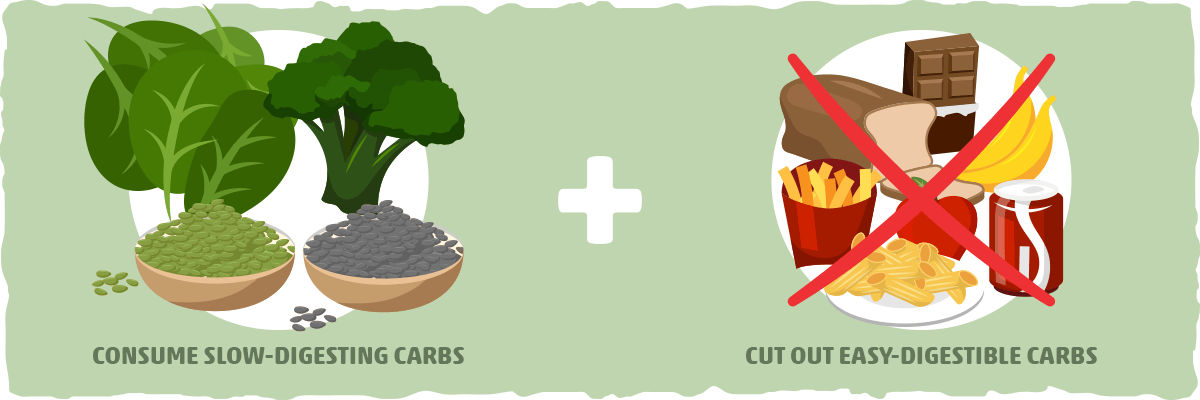
The Slow Carb Diet was birthed from the mind of best selling author Tim Ferriss. This unique dietary approach is the result of his attempt to condense what he learned about healthy eating and sustainable fat loss results into a minimum effective dose of lifestyle behaviors.
In other words, his goal with slow carb is to help you get the maximum results by doing the minimum amount of work possible. This is where the phrase “slow carb” comes into play.
Slow carb refers to the “slow-digesting carbs” (i.e., legumes) that are allowed on the diet. Rather than restricting carb intake to a specific carb limit or percentage of calories, Ferriss simply recommends cutting out all easily-digestible carbs, highly processed foods, and high fructose fruits.
In essence, this leaves you with the following food groups: animal protein, low-starch vegetables, legumes, fats, and spices. Though simplifying your meals to these options can help you lose fat, it is recommended to implement each one of Ferriss’s slow-carb rules and tips for optimal results.
The Five Rules of the Slow Carb Diet
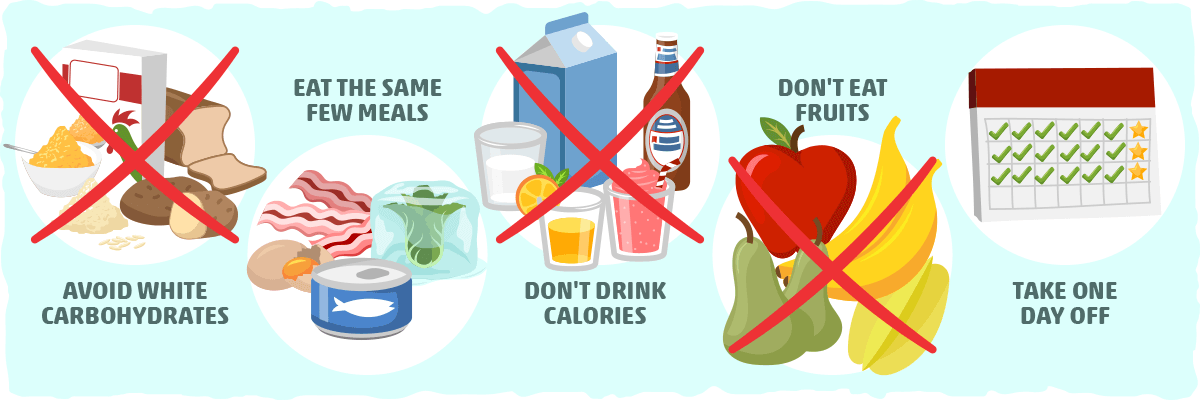
Instead of looking at your diet through the frame of calories and macronutrients, the Slow Carb diet focuses on these five simple rules:
Rule #1: Avoid “white” carbohydrates
This means anything made from grains (including corn, rice, and quinoa), white potatoes, flour, and breaded things (like fried chicken). “White” carb sources that are not part of this rule include white beans, garbanzo beans, and cauliflower.
In other words, if it’s not a legume or a low-carb vegetable and it’s filled with starch, it is best to avoid it.
The inverse of this rule is to only get your carbs from slow-digesting (or “slow-burning”) sources, like legumes and low-carb vegetables. (Important caveat: The digestibility of carb-rich foods varies from person to person. This is one of the key criticisms of slow carb dieting that we will unpack later in this article.)
Rule #2: Eat the same few meals over and over again
Pick from the slow-carb food list and recipes below, and stick with a simple rotation of meals. This will help minimize the stress of dieting and reduce the risk of overeating.
Simple whole foods like eggs, bacon, canned fish (e.g., tuna, salmon, sardines), frozen veggies, and canned beans are easy to turn into quick meals. You can also choose a few staple slow-carb recipes and stick with them throughout the week (scroll down to the recipe section for some delicious ideas).
Rule #3: Don’t drink calories
Liquid calories are less satiating than solid calories. This means you should avoid soda, juice, smoothies, alcohol, and milk while you are going slow carb.
Tim Ferriss does, however, make an exception for a glass or two of red wine and one 16oz diet soda per day.
For best results, you should only drink water, tea, and/or coffee. Even though red wine and diet soda are relatively low in calories, they can indirectly contribute to slowed weight loss.
Rule #4: Don’t eat fruit
The reasoning behind this rule is to avoid fructose, which is found in high quantities in most fruit. On his blog, Tim claims that “fructose –> glycerol phosphate –> more bodyfat, more or less.” (Though this is true in a state of energy excess, it is less likely to occur while we are in an energy deficit.)
The only exceptions to this rule are avocados and tomatoes, which have a very low fructose content.
Rule #5: Take one day off per week
Also known as “cheat day” or “faturday,” simply take one day a week where you can indulge all your cravings. The previous four rules do not apply during cheat day.
Bonus rule: Experiment, track, and adjust
The five slow-carb rules may be all you need to transform your body and overall health for the better, but this bonus rule may be what you need to maintain your results for life.
For example, you may be able to add in other whole foods, such as parmesan cheese, cottage cheese, or sweet potatoes, without impairing your slow carb results.
To personalize your approach, simply add 1 or 2 foods into your diet for 4 weeks and assess your results to see if your health and body composition are still trending in the right direction.
When in doubt, experiment, assess, and adjust. With each iteration, you will be able to formulate a diet that is more optimal for you.
Other Common Tips and Recommendations for Optimal Results with Slow Carb
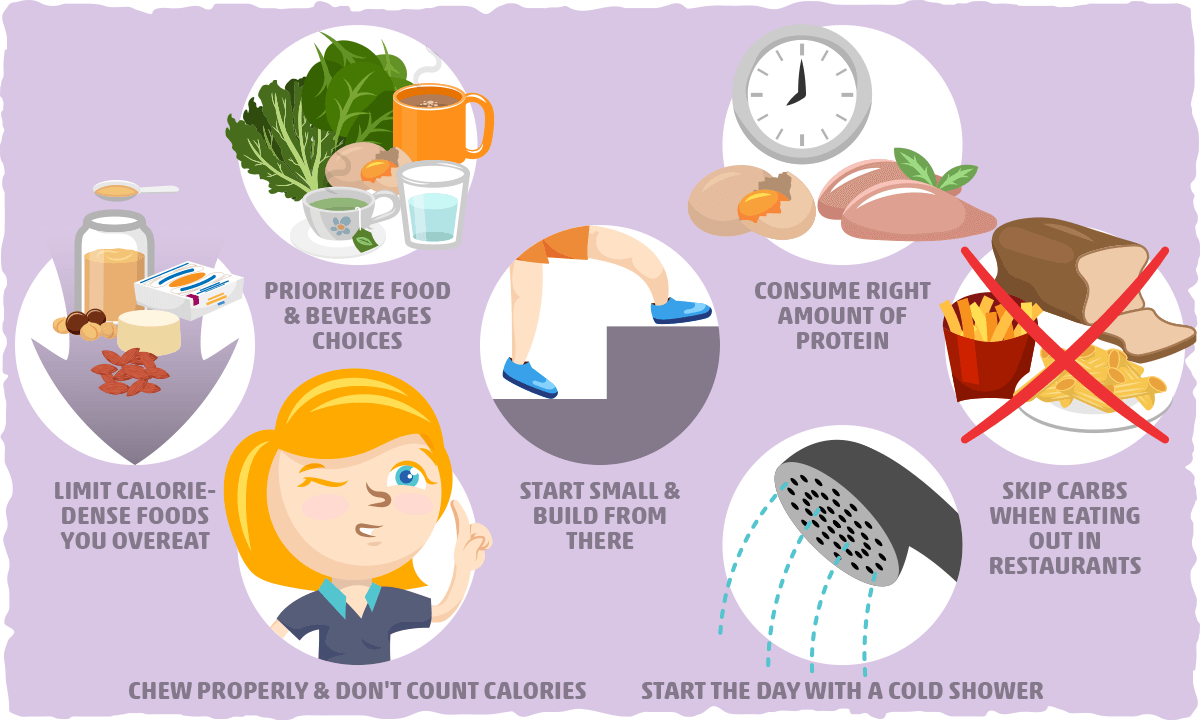
In his book, The Four Hour Body, and after collecting years of feedback from slow carb dieters, Ferriss provided a few tips that you can use to increase your chances of success.
Tip #1: How to prioritize your food and beverages choices for optimal results
Eat plenty of vegetables and eggs. According to the survey data that Tim collected on slow-carb dieters, egg intake and veggie consumption were both strongly correlated with weight loss results.
Conversely, alcohol consumption was correlated with suboptimal results. For this reason, it may be best to limit overall alcohol consumption during slow-carb days and cheat days.
Tip #2: Get the right amount of protein at each meal
According to the slow-carb diet, it is best to consume a breakfast that consists of at least 30 grams of protein within an hour of waking. This can have positive effects on satiety and blood sugar stabilization throughout the day.
After breakfast, meals should be spaced out approximately four hours apart, which usually means eating 3-4 meals per day. Each one of these meals should consist of more than 20 grams of protein.
Though snacking is best avoided, you can have a small meal of just protein or protein and veggies if you are still hungry after a meal.
Tip #3: Limit calorie-dense foods you tend to overeat
Even though highly palatable health foods like nuts, nut butter, and hummus are allowed on the slow-carb diet, people tend to overeat them. If you find yourself eating multiple servings of a food in one sitting, then it is best to limit your consumption of it.
Tip #4: Skip the restaurant carbs
Always opt for low-carb vegetables instead of rice, pasta, potatoes, or fries. For a more comprehensive look at what you can order when you eat out, follow this link.
Tip #5: Don’t count calories
Rather than counting calories, focus on eating slow-carb-friendly foods until you feel full.
Chew thoroughly and eat slowly to get the most out of your meals and stay fuller for longer. This will also help decrease your glycemic response and keep cravings away.
Tip #6: Start the day with a cold shower
One lifestyle hack that Ferriss recommends implementing along with the slow carb diet is daily cold showers. Interestingly enough, Tim found that those who tried taking cold showers and gave up often quit the diet as well.
Tip #7: Start small and build from there
If you feel overwhelmed by all these diet and lifestyle changes, just start with one small step at a time. For example, try starting with a protein-rich breakfast (with 30 g of protein) within 60 minutes of waking or cut out all liquid sources of calories from your diet.
Start with small, manageable changes and gradually build more rules into your routine once you feel comfortable.
How Does it Work? Slow Carb Diet Results Before & After
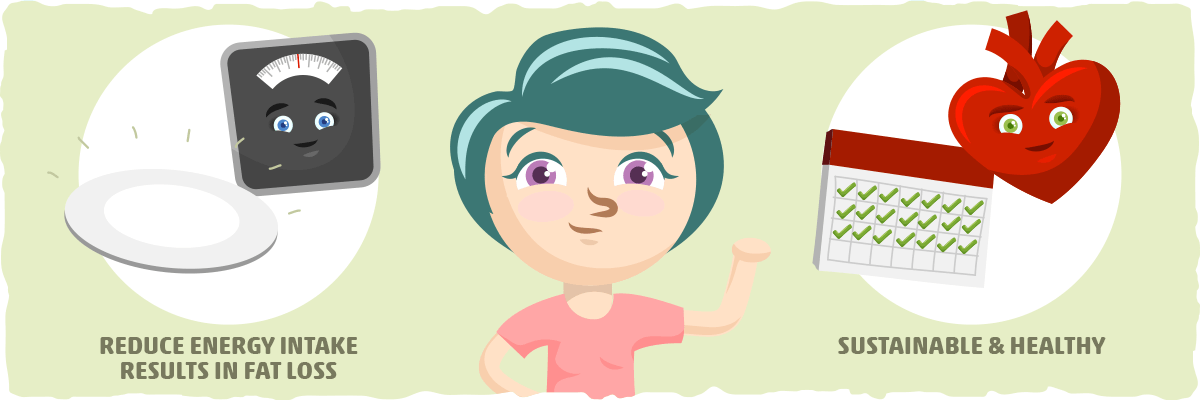
According to his slow carb survey, Tim found that 84% of people who stuck to the diet for four weeks lost weight and 14% of slow-carbers lost more than 15 pounds in that time span.
Put in another way, this means that 14 out of every 100 people who followed the slow carb diet for four weeks lost more than 3.75 pounds per week. That’s a lot of fat loss for such a short amount of time!
That being said, we must keep in mind that these results are not unique to the slow carb diet. In fact, it is relatively common for someone who is overweight or obese to lose fat rapidly after making a significant change to their diet and sticking to it for four weeks.
For example, let’s compare and contrast three different approaches: keto, paleo, and slow carb. Though they are based on different rules and principles, each one has helped induce rapid fat loss results for thousands of people.
The secret behind each diet’s incredible success stories is not eating like a caveman, following slow carb rules, or restricting net carbs to zero. Rather, each one works by the same mechanism: reducing overall energy intake enough to promote fat loss.
This is the common denominator that explains why such different dietary strategies can help us lose weight, from high-carb vegan diets to zero-carb carnivores and everything in between.
Unfortunately, knowing exactly how a diet works won’t make it work for you. The most important factor behind getting the results you want and maintaining them for life is formulating a diet that is sustainable and healthy for you.
The first step will always be to experiment with something that you think will fit with your lifestyle, your health goals, and your preferences. To help you decide if the slow carb diet is worth a try for you, let’s look at the potential downsides of this approach.
The Other Side of the Story: Criticisms and Potential Downsides of Slow Carb
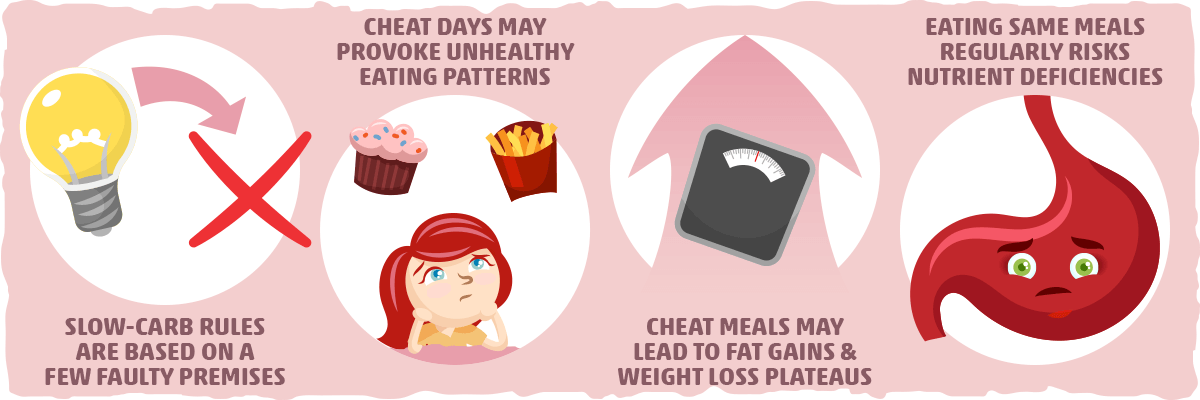
Despite the potential for incredible results with the slow-carb approach, it has many methodological weaknesses that can mislead us into struggling with our weight and health more than before. By addressing these potential downsides, we can help illuminate the path to an optimal diet for you.
Here are the most glaring vulnerabilities I’ve found with the slow carb diet:
● The rules are based on a few faulty premises.
Though following the slow-carb rules can lead many of us to sustainable body transformations, this does not mean that the reasoning behind each rule is sound. For example, the concept of universally slow-digesting/slow-burning carbs (that the name “slow carb diet” is based on) is not supported by the literature.
In fact, the current research suggests that the glycemic response to carb-rich foods is highly individual (and it even varies from day to day and meal to meal). This means that someone can still experience a significant increase in blood sugar and insulin after eating a 100% slow carb meal, which is exactly what Ferriss was trying to avoid with his slow carb rules.
That being said, it is not feasible nor necessary for someone to track their glycemic response after each meal to lose fat and improve health. For sustainable weight loss results, it is best to place your focus on creating a lifestyle that helps you eat less food, burn stored fat, and improve overall health without feeling restricted.
If the slow carb diet meets these criteria for you, then it is worth trying. However, try not to let the concept of “slow digesting carbs” keep you from finding a more sustainable diet if you struggle with this approach.
● Cheat days may provoke unhealthy eating patterns and impair mental well-being throughout the week.
A simple rule-based approach like slow-carb can trigger an unhealthy obsession with food choices that may wear away at our mental health over time.
For some of us, simply knowing we have one cheat day each week is enough to trigger incessant daydreaming about those cheat meals, provoke binge-eating behaviors, and prevent us from enjoying our slow-carb meal days.
Along with that, cheat meals can cause massive fluctuations in water retention, inflammation, and energy levels, which can be difficult for many of us to come back from. This is particularly important to take into consideration if you have struggled with body dysmorphia, eating disorders, and depression in the past.
● Cheat meals can still promote fat gain and weight loss plateaus.
Ideally, six days of slow-carb eating will induce more than enough fat loss to counteract the increased calorie consumption on your cheat day. Unfortunately, this will not be the case for everyone who follows this type of diet plan.
For some, just one cheat day will be all it takes to gain the fat that was lost throughout the week. The likelihood of this happening will increase even more if your cheat day primarily consists of highly-processed foods, sugary drinks, and alcohol.
To find out if your cheat day is cheating you, make sure you are monitoring your results every 4-6 weeks on the same day each time.
Please note: If you weigh yourself and take circumference measurements after your cheat day, they will be higher than expected due to increased water retention. This is why it is important to assess your results on the same day of the week, every 4-6 weeks.
● Eating the same meals can increase the risk of nutrient deficiencies.
If you were to follow rule #2 precisely, it is possible to run into several vitamin and mineral deficiencies after a few months. This is why, as with any other major dietary change, it is crucial that you monitor your health and well-being. Unexpected symptoms and health issues may indicate an underlying deficiency, which can easily be corrected by switching up your diet or supplementing.
How to Know if Slow Carb is Right for You
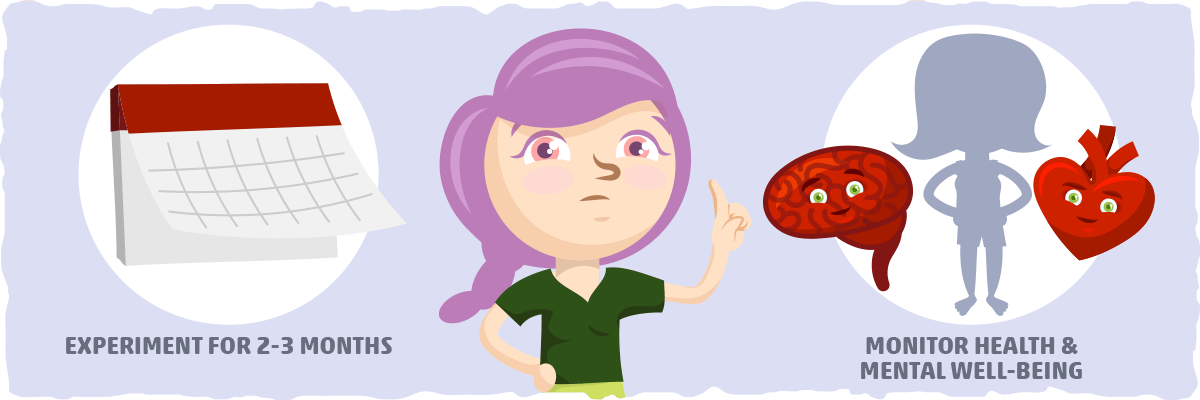
With the potential downsides and benefits in mind, you will be able to establish a better idea of what to expect from this approach.
If slow-carb looks a lot like something that has not worked for you in the past, then there is no reason to think that slapping a “slow carb” label on it will be any better for you. Instead, you may want to try a more consistent and straightforward low-carb approach like the keto diet.
For those of you who haven’t tried anything like the slow carb diet, the only way to know if it will work is by experimenting with it for 2-3 months.
Throughout the process, make sure you are monitoring your physical health and mental well-being. Your body composition, mental health, and blood work should all be trending in a positive direction after each month.
Slow Carb Food List: What to Eat and Avoid
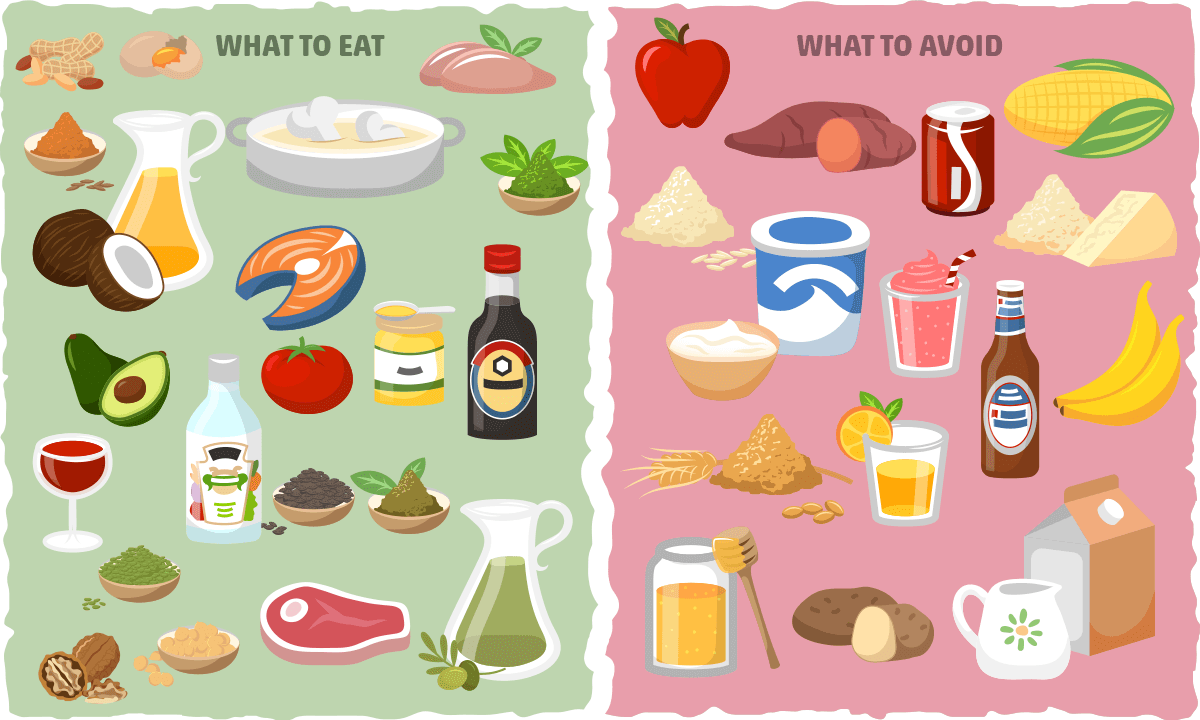
To help you get started with this approach, here is a comprehensive list of slow-carb foods:
- Animal Protein — eggs, fish, shellfish, organ meat, red meat, game, poultry, etc.
- Low-carb vegetables — leafy greens, crucifers, and anything else from our low-carb vegetables list
- Legumes — lentils, chickpeas, peanuts, and any other bean variety
- Herbs and spices — basil, mint, curry, cumin, oregano, etc.
- Nuts and seeds — macadamias, cashews, pecans, walnuts, chia seeds, flaxseeds, etc.
- Fats/Oils — avocados, nut butter, ghee, grass-fed butter, extra virgin olive oil, macadamia oil, and coconut oil
- Others — tomatoes, bone broth, coconut milk, hummus, vinegar, soy sauce, and low-carb condiments.
And, of course, 1-2 glasses of red wine (Malbec is often recommended).
Foods to avoid on a slow carb diet:
- Grains – wheat, corn, rice, cereal, oats, etc.
- Sugar – honey, agave, maple syrup, etc.
- Drinks with calories — soda, alcohol, juice, smoothies, etc.
- Fruit – apples, bananas, oranges, berries, etc.
- Starchy vegetables – potatoes, yams, beets, etc.
- Dairy* — yogurt, cream, half and half, cheese, etc.
*Grass-fed butter is the only exception here.
Lastly, here is a list of foods that some slow-carb dieters were able to add back into their diets successfully:
- Acorn Squash
- Beets
- Butternut Squash
- Carrots
- Jicama
- Parsnips
- Pumpkin
- Squash
- Sweet Potato
- Yam
- Berries
- Sugar-free cottage cheese
- Parmesan cheese and other hard cheeses
According to the slow carb diet guidelines, it is best to stick to the slow-carb food list above for best results. To get a better idea of what your meals will look like, we’ve provided several slow-carb recipes and a meal plan below.
Slow Carb Diet Recipes (that are also keto-friendly)
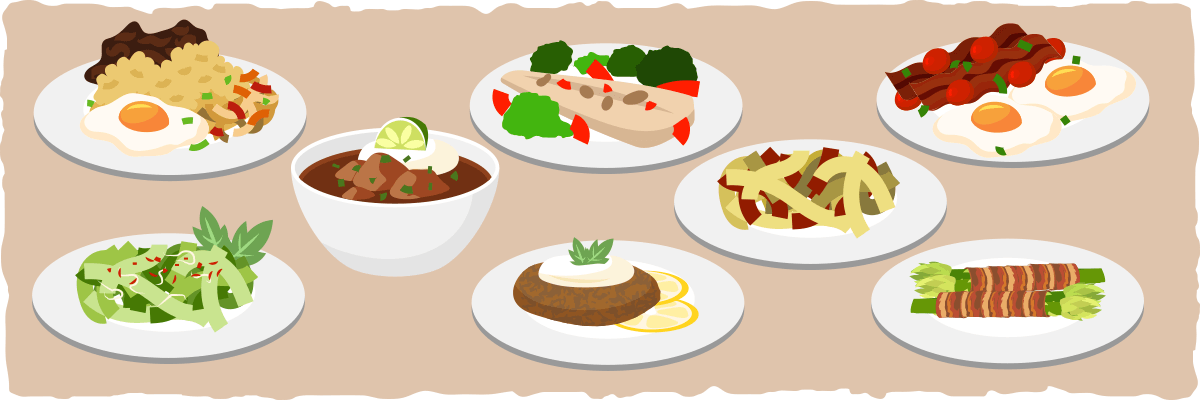
Since eating more eggs on a slow carb diet is associated with better results, this recipe will be an excellent staple for your weekly rotation. And don’t forget about the tomatoes! They will enhance the flavor and health benefits of your meal even more.
If you are looking to follow tip #2 (i.e., eat at least 30 grams of protein within 60 min of waking), simply have three eggs instead of two.
2. Keto Crispy Ginger Mackerel Lunch Bowl
This slow-carb bowl has it all — veggies, protein, healthy fats, micronutrients, and flavor. Follow the recipe step-by-step or make your own concoction using this bowl as inspiration.
Canned salmon, tuna, and sardines will work wonderfully with this mix of flavor as well, so don’t be afraid to experiment with what you have on hand!
3. One-Pan Cabbage and Bacon Keto Bowl
Do you like the idea of a slow-carb bowl, but you’re not a fan of fish? Try this simple, quick, and delicious cabbage and bacon recipe. All you’ll need is one pan and three ingredients: bacon, cabbage, and butter.
This can also be made as a full meal or served as a side dish with your favorite steak or pork chop recipe.
4. Bacon Wrapped Asparagus with Garlic Aioli
Another side to consider on the slow carb diet is bacon wrapped asparagus. There is something about the combination of bacon flavor with this keto vegetable that is uniquely satisfying. In fact, it’s so good that you may not need to make the aioli.
That being said, the garlic aioli is so versatile, creamy, and delicious that I recommend making it at least once. Just make sure you use a high-quality keto mayo as your base, and you’ll have a condiment you can use to add flavor and fat to any slow carb meal.
5. Zucchini Ribbons & Avocado Walnut Pesto
If you’d like to make a vegetarian-friendly slow-carb meal, look no further than this recipe. It is packed with the pesto flavor we love without any high-carb ingredients like bread or pasta.
Unfortunately, to make it completely slow carb compliant, you should cut out the parmesan cheese (or try experimenting with it to see if you can incorporate cheese without slowing your slow-carb results).
6. Slow Cooker Steak Lovers Chili
This chili variation is filled with slow-carb protein and can be served as a hearty, delicious breakfast, lunch, or dinner. It is surprisingly filling for how low it is in overall calories, which makes it an ideal meal for promoting fat loss.
For some extra fat, feel free to top it with avocado and a drizzle of extra virgin olive oil.
These salmon cakes are so satisfying — even if you are not a fan of fish. Simply omit the parmesan cheese to make it 100% slow carb compliant (or add it in if you find that parmesan doesn’t stall your results).
You can also serve it with a low-carb vegetable of your choice like roasted broccoli or a side salad for a complete keto-friendly slow-carb dinner.
This bowl is a lot like steak and eggs, but with an extra kick from garlic, soy sauce, and Calamansi juice (the juice from a philippine lime). It also combines two of the foods that were strongly correlated with slow-carb success: eggs and low-carb vegetables.
If you don’t have access to Calamansi or its juice, feel free to keep it out of the recipe or replace it with lemon or lime juice.
Slow Carb Meal Plan: One Week of Keto-Friendly Slow Carb Eating
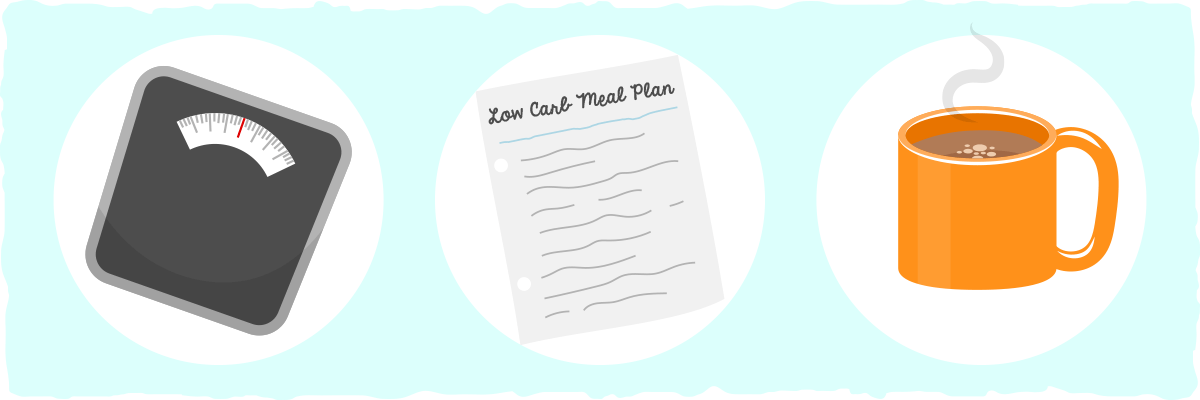
For this 7-day meal plan, we will be incorporating the rules of slow-carb eating along with the keto-friendly recipes from the previous section. This means that each breakfast should contain at least 30 grams of protein, and all meals will be kept simple.
Day 1
Breakfast (within one hour of waking): 1 serving of Keto Breakfast Bowl [make 2 servings, store some for breakfast on Day 2]
Lunch: 1 serving of Keto Crispy Ginger Mackerel Lunch Bowl [make 2 servings, store some for dinner on Day 3]
Dinner: 2 servings of Slow Cooker Steak Lovers Chili [make 6 servings, store some for Day 2, Day 3, and Day 6]
Day 2
Breakfast (within one hour of waking): 2 servings of Keto Breakfast Bowl [leftover]
Lunch: 2 servings of Slow Cooker Steak Lovers Chili [leftover]
Dinner: 1-2 servings of Zucchini Ribbons & Avocado Walnut Pesto [make 2-4 servings, store some to use for lunch on Day 5]
Day 3
Breakfast (within one hour of waking): 1 serving of Classic Bacon and Eggs with one extra egg
Lunch: 1 serving of Slow Cooker Steak Lovers Chili [leftover]
Dinner: 1 serving of Keto Crispy Ginger Mackerel Lunch Bowl [leftover]
Day 4
Breakfast (within one hour of waking): 1 serving of Classic Bacon and Eggs with one extra egg
Lunch: 1 serving of One-Pan Cabbage and Bacon Keto Bowl [make 2 servings, store some for dinner on Day 5]
Dinner: 1 serving of Cajun Salmon Cakes with 1-2 servings of Lemon Roasted Spicy Broccoli [make 3 servings of salmon cakes, store some for Day 5 and Day 6]
Day 5
Breakfast (within one hour of waking): 1 serving of Cajun Salmon Cakes [leftover]
Lunch: 1-2 servings of Zucchini Ribbons & Avocado Walnut Pesto [leftover]
Dinner: 1 serving of One-Pan Cabbage and Bacon Keto Bowl [leftover]
Day 6
Breakfast (within one hour of waking): 1 serving of Cajun Salmon Cakes [leftover]
Lunch: 1 serving of Bacon Wrapped Asparagus with Garlic Aioli [make 2 servings, store some to serve 1 at dinner]
Dinner: 1 serving of Slow Cooker Steak Lovers Chili with leftover Bacon Wrapped Asparagus with Garlic Aioli [leftover]
Day 7: Cheat Day
There are no rules for a cheat day on the slow carb diet. Consume whatever you want, whenever you want.
Keep in mind, however, that if your weight loss stalls (or you start gaining fat), you may want to consider moderating your intake of certain foods and beverages during your cheat day. I recommend starting with a calorie-containing food or drink that you won’t mind limiting or eliminating from your diet completely.
Key Takeaways: Slow Carb, Keto, and Optimal Weight Loss Results
Now that you have a good idea of what a slow carb diet looks like, it will be easier to decide if it’s the right fit for you vs. other popular low-carb diets.
Whether you experiment with slow carb, keto, paleo, or a more lenient low carb approach, each one has the potential to improve health and boost fat loss. The most important question to consider is if the diet will help you maintain better health and weight loss results for the long term.
If sticking with your new diet wears away at your well-being over time and requires endless amounts of willpower and restriction, then that diet and the results you get from it will be much more challenging to sustain.
Given our different food environments, lifestyles, and health conditions, it will take some trial and error to formulate the ideal diet for you — whether it is a variation of slow carb, keto, or something completely different.
To help you personalize your diet for optimal results, we’ve included several resources below with information and tips that can be applied to virtually any weight loss journey:
- How to Lose Weight on a Ketogenic Diet
- Keto Plateau Buster – What To Do When Weight Loss Stalls
- How to Maintain Your Weight Loss Results for Life
Sources
- Is The 4-Hour Body a Scam? Tracking 3,500 People to Find Out — The Tim Ferriss Show
- Keto & Weight Loss — Ruled.me
- Personalized Approach to Predicting Postprandial Glycemic Responses to Food — JAMA
- Variability of glycemic and insulin response to a standard meal, within and between healthy subjects. — NCBI
- The Four Hour Body — Tim Ferriss
- Fructose and metabolic health: governed by hepatic glycogen status? — The Journal of Physiology